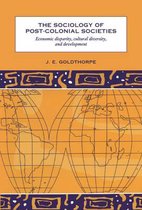ROOTS 1 - Insights into Social Inequality A Quantitative Study of Neolithic to Early Medieval Societies in Southwest Germany
Afbeeldingen
Sla de afbeeldingen overArtikel vergelijken
Auteur:
Ralph Grossmann
- Engels
- Hardcover
- 9789088909788
- 15 juni 2021
- 236 pagina's
Samenvatting
Social inequality is a subject of contemporary concerns. Life capabilities and the access to resources vary significantly in rich and poor countries, between elites and others. Furthermore, inequalities based on bio-anthropological and non-bio-anthropological causes are almost universal. Accordingly, inequality was also inherent in past societies and archaeologists have continually examined and interpreted social inequalities in sources such as burial grounds.
This book continues such analyses with a new multi-proxy approach. It reveals social inequalities in selected past burial grounds from Southwestern Germany. The burial grounds date to the Early Neolithic (Schwetzingen), the Late Neolithic (Lauda-Königshofen), the Early Bronze Age (Singen), the Early Iron Age (Magdalenenbergle), and the Early Medieval period (Horb-Altheim). The challenge was to identify hierarchical and heterarchical differences and inequalities within the burial grounds based on a multitude of different proxies. The examination encompasses variations in the distribution of grave goods, burial pit sizes, bio-anthropological and isotope data. Furthermore, spatial analyses of burial grounds and, in particular, on the distances between the graves play an essential role in this examination.
The results reveal social inequalities among and within genders and age cohorts that are differently pronounced in the respective cemeteries. Furthermore, the results of multi-proxy analyses lead to the interpretation that the sites differ concerning the respective degrees of inequality and power strategy modes. In detail, it can be observed that the Early Iron Age and the Early Bronze Age sites demonstrate a relatively high degree of inequality as compared to the other sites. More specifically, the investigation of sites from the Early Iron Age and the Late Neolithic rather reveal a network-based power strategy, whereas sites from the Early Neolithic, the Early Bronze Age and the Early Medieval period tend to show a corporate-based power strategy.
Contents:
1. Introduction
2. Social theories of social inequality
3. Empirical approach to social inequality
4. Methods
4.1. Differences in values of grave goods and burial pit sizes
4.2. Bio-anthropological data
4.3. Stable isotope analyses
4.4. Pathologies
4.5. Spatial analyses
4.6. Statistical tests
5. Source critique
6. Schwetzingen (Early Neolithic)
6.1. Spatial analysis
6.2. Values of grave goods
6.3. Burial pit sizes
6.4. Values of grave goods and burial pit sizes
6.5. Lorenz curves and Gini indices
6.6. Distance to the next burial
6.7. Diet and status
6.8. Body height
6.9. Hierarchy, heterogeneity, transformation
6.10. Summary
7. Lauda-Königshofen (Late Neolithic)
7.1. Spatial analysis
7.2. Values of grave goods
7.3. Burial pit sizes
7.4. Values of grave goods and burial pit sizes
7.5. Lorenz curves and Gini indices
7.6. Distance to the next burial
7.7. Diet, growth and status: Nitrogen (δ15N)
7.8. Hierarchy, heterogeneity, transformation
7.9. Summary
8. Singen on Hohentwiel (Early Bronze Age)
8.1. Spatial analysis
8.2. Values of grave goods
8.3. Burial pit sizes
8.4. Values of grave goods and burial pit sizes
8.5. Lorenz curves and Gini indices
8.6. Distance to the next burial
8.7. Diet, growth and status: Nitrogen (δ15N)
8.8. Heterogeneity and transformation
8.9. Strontium isotope analysis
8.10. Summary
9. Magdalenenbergle of Villingen (Early Iron Age)
9.1. Spatial Analysis
9.2. Values of grave goods
9.3. Burial pit sizes
9.4. Values of grave goods and burial pit sizes
9.5. Lorenz curves and Gini indices
9.6. Distance to the central burial
9.7. Diet and social position: Nitrogen isotope analysis (δ15N)
9.8. Tooth decay
9.9. Strontium isotope analysis
9.10. Summary
10. Horb-Altheim (Early Medieval)
10.1. Spatial analysis
10.2. Values of grave goods
10.3. Burial pit sizes
10.4. Lorenz curves and Gini indices
10.5. Values of grave goods and burial pit sizes
10.6. Distance to the next burial
10.7. Growth and body height
10.8. Pathologies
10.9. Heterogeneity and transformation
10.10. Summary
Summary
Conclusion
References
Productspecificaties
Wij vonden geen specificaties voor jouw zoekopdracht '{SEARCH}'.
Inhoud
- Taal
- en
- Bindwijze
- Hardcover
- Oorspronkelijke releasedatum
- 15 juni 2021
- Aantal pagina's
- 236
- Illustraties
- Met illustraties
Betrokkenen
- Hoofdauteur
- Ralph Grossmann
- Hoofduitgeverij
- Sidestone Press
Overige kenmerken
- Editie
- 1
- Product breedte
- 216 mm
- Product hoogte
- 19 mm
- Product lengte
- 284 mm
- Studieboek
- Ja
- Verpakking breedte
- 216 mm
- Verpakking hoogte
- 19 mm
- Verpakking lengte
- 284 mm
- Verpakkingsgewicht
- 1055 g
EAN
- EAN
- 9789088909788
Kies gewenste uitvoering
Kies je bindwijze
(2)
Prijsinformatie en bestellen
De prijs van dit product is 135 euro.
2 - 3 weken
Verkoop door bol
- Prijs inclusief verzendkosten, verstuurd door bol
- Ophalen bij een bol afhaalpunt mogelijk
- 30 dagen bedenktijd en gratis retourneren
- Dag en nacht klantenservice
Rapporteer dit artikel
Je wilt melding doen van illegale inhoud over dit artikel:
- Ik wil melding doen als klant
- Ik wil melding doen als autoriteit of trusted flagger
- Ik wil melding doen als partner
- Ik wil melding doen als merkhouder
Geen klant, autoriteit, trusted flagger, merkhouder of partner? Gebruik dan onderstaande link om melding te doen.










